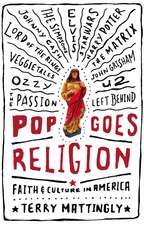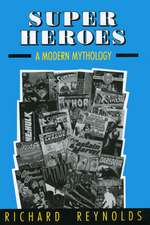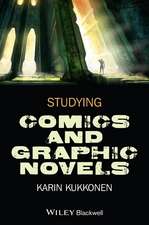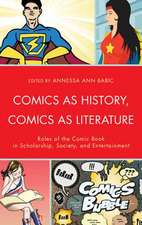Comics and the Senses: A Multisensory Approach to Comics and Graphic Novels: Routledge Research in Cultural and Media Studies
Autor Ian Hagueen Limba Engleză Hardback – 6 feb 2014
Din seria Routledge Research in Cultural and Media Studies
-
 Preț: 311.81 lei
Preț: 311.81 lei -
 Preț: 311.61 lei
Preț: 311.61 lei -
 Preț: 309.50 lei
Preț: 309.50 lei -
 Preț: 364.71 lei
Preț: 364.71 lei -
 Preț: 325.59 lei
Preț: 325.59 lei -
 Preț: 310.85 lei
Preț: 310.85 lei -
 Preț: 310.99 lei
Preț: 310.99 lei -
 Preț: 272.01 lei
Preț: 272.01 lei -
 Preț: 318.07 lei
Preț: 318.07 lei - 9%
 Preț: 1005.52 lei
Preț: 1005.52 lei - 9%
 Preț: 934.94 lei
Preț: 934.94 lei -
 Preț: 389.85 lei
Preț: 389.85 lei -
 Preț: 334.02 lei
Preț: 334.02 lei - 8%
 Preț: 382.97 lei
Preț: 382.97 lei -
 Preț: 301.58 lei
Preț: 301.58 lei -
 Preț: 309.27 lei
Preț: 309.27 lei -
 Preț: 362.42 lei
Preț: 362.42 lei -
 Preț: 311.41 lei
Preț: 311.41 lei -
 Preț: 327.02 lei
Preț: 327.02 lei -
 Preț: 309.31 lei
Preț: 309.31 lei -
 Preț: 420.36 lei
Preț: 420.36 lei -
 Preț: 485.07 lei
Preț: 485.07 lei - 18%
 Preț: 1231.89 lei
Preț: 1231.89 lei -
 Preț: 418.56 lei
Preț: 418.56 lei - 18%
 Preț: 1222.85 lei
Preț: 1222.85 lei - 18%
 Preț: 1055.51 lei
Preț: 1055.51 lei -
 Preț: 441.96 lei
Preț: 441.96 lei - 18%
 Preț: 1061.57 lei
Preț: 1061.57 lei - 18%
 Preț: 1116.38 lei
Preț: 1116.38 lei - 18%
 Preț: 1061.22 lei
Preț: 1061.22 lei - 18%
 Preț: 1051.72 lei
Preț: 1051.72 lei - 18%
 Preț: 1056.14 lei
Preț: 1056.14 lei - 18%
 Preț: 1054.97 lei
Preț: 1054.97 lei - 18%
 Preț: 1107.94 lei
Preț: 1107.94 lei - 18%
 Preț: 1056.63 lei
Preț: 1056.63 lei - 18%
 Preț: 1066.79 lei
Preț: 1066.79 lei - 18%
 Preț: 1117.77 lei
Preț: 1117.77 lei - 18%
 Preț: 1281.24 lei
Preț: 1281.24 lei - 18%
 Preț: 1005.01 lei
Preț: 1005.01 lei - 18%
 Preț: 737.98 lei
Preț: 737.98 lei
Preț: 701.95 lei
Preț vechi: 856.03 lei
-18% Nou
134.31€ • 140.24$ • 111.16£
Carte în stoc
Livrare din stoc 25 februarie
Specificații
ISBN-10: 0415713978
Pagini: 214
Ilustrații: illustrations
Dimensiuni: 152 x 229 x 18 mm
Greutate: 0.43 kg
Ediția:1
Editura: Taylor & Francis
Colecția Routledge
Seria Routledge Research in Cultural and Media Studies
Locul publicării:Oxford, United Kingdom
Public țintă
Postgraduate and UndergraduateCuprins
Introduction 1. Eye Like Comics, or, Ocularcentrism in Comics Scholarship 2. Sight, or, the Ideal Perspective and the Physicality of Seeing 3. Hearing, or, Visible Sounds and Seeing With the Ears 4. Touch, or, the Taboo/Fetish Character of Comics and Tactile Performance 5. Smell and Taste, or, the Scent of Nostalgia and the Flavour of Advertising 6. Multisensory Aspects of the Comics of Alan Moore Conclusion
Notă biografică
Ian Hague is Associate Lecturer in the History Department at the University of Chichester, UK.
Recenzii
- Pedro Moura, University of Lisbon and the University of Leuven, in IMAGE & NARRATIVE
"Comics and the Senses is not just a highly original work within Cultural Studies, it also develops a framework of wide significance for all of the Humanities."
- Paolo Cardullo, Goldsmiths, University of London, in Visual Studies
"Comics and the Senses succeeds in providing "a starting point, a catalogue, of the multisensory elements of comics," and it details several exciting ways in which comics have moved into 21st-century electronic media... [it] is an admirable resource for accessing scholarly theories about comics and for considering directions that future scholarship could take in relation to a rapidly expanding comics industry." - Brian Bates , ImageText
"Clearly written, with careful explanations and background information...a thought-provoking read, especially in its attempt to underscore theperformativity of comics reading experiences and the role of comics formats in moulding those experiences." - Maaheen Ahmed, Université Catholique de Louvain, in European Comic Arts
Descriere
Attempts to define what comics are and explain how they work have not always been successful because they are premised upon the idea that comic strips, comic books and graphic novels are inherently and almost exclusively visual. This book challenges that premise, and asserts that comics is not just a visual medium. The book outlines the multisensory aspects of comics: the visual, audible, tactile, olfactory and gustatory elements of the medium. It rejects a synaesthetic approach (by which all the senses are engaged through visual stimuli) and instead argues for a truly multisensory model by which the direct stimulation of the reader’s physical senses can be understood. A wide range of examples demonstrates how multisensory communication systems work in both commercial and more experimental contexts. The book concludes with a case study that looks at the works of Alan Moore and indicates areas of interest that multisensory analysis can draw out, but which are overlooked by more conventional approaches.






